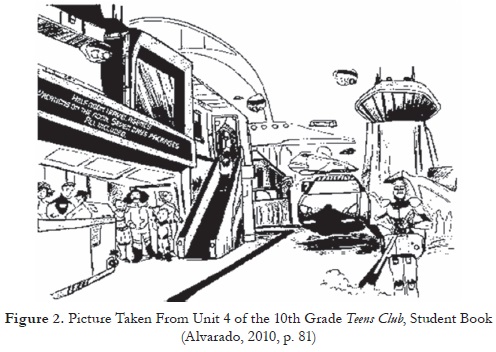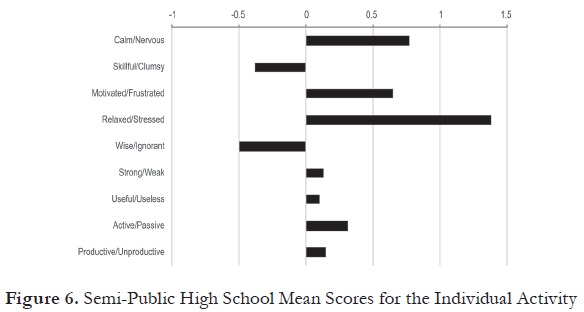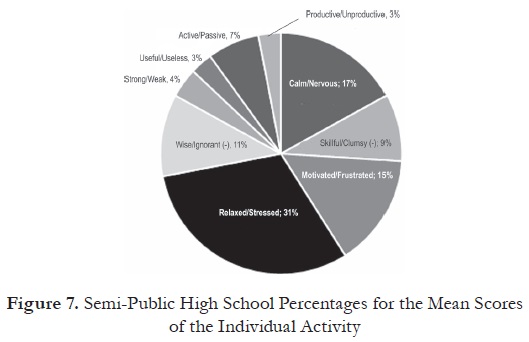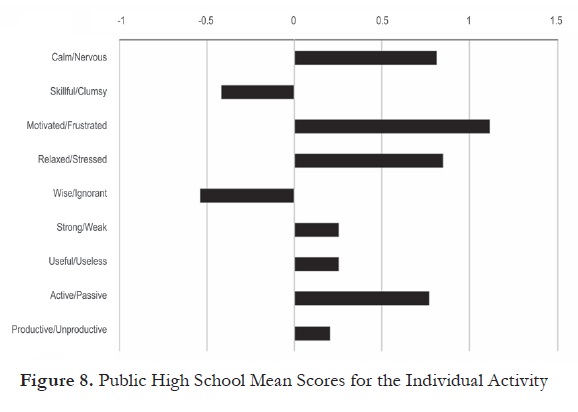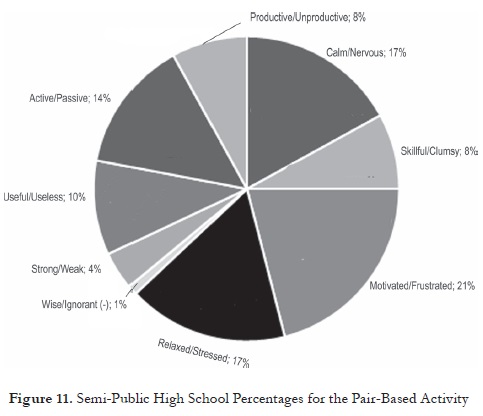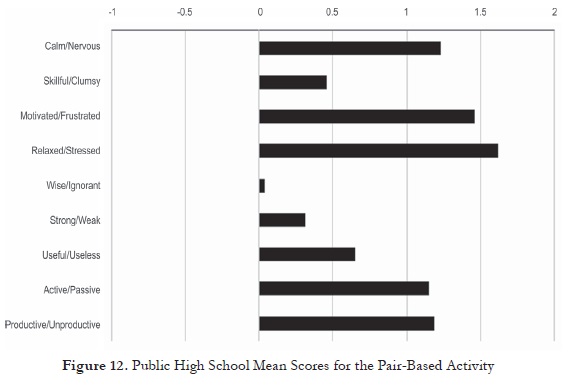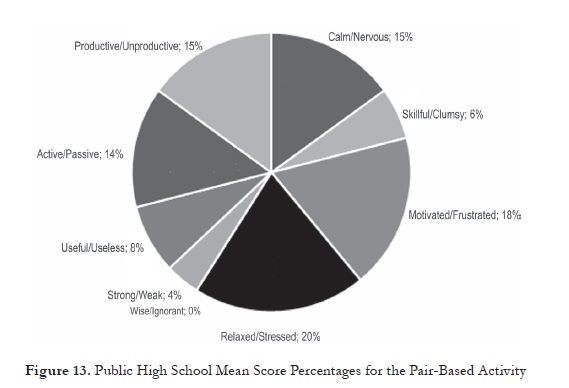Services on Demand
Journal
Article
Indicators
-
 Cited by SciELO
Cited by SciELO -
 Access statistics
Access statistics
Related links
-
 Cited by Google
Cited by Google -
 Similars in
SciELO
Similars in
SciELO -
 Similars in Google
Similars in Google
Share
How
Print version ISSN 0120-5927
How vol.24 no.2 Bogotá July/Dec. 2017
https://doi.org/10.19183/how.24.2.346
http://dx.doi.org/10.19183/how.24.2.346
High School Students’ Affective Reaction to English Speaking Activities
La reacción afectiva de estudiantes de secundaria hacia las actividades de expresión oral en inglés
Oliver Camilo Jorquera Torresa
Jhon Eliot Mendoza Zapatab
Claudio Heraldo Díaz Larenasc
aEscuela Particular José Miguel Carrera, Santiago, Chile. E-mail: eldaliejt@gmail.com.
bLiceo Miguel Ángel Cerda Leiva, Mulchen, Chile. E-mail: jhonmendoza@udec.cl.
cUniversidad de Concepción, Concepción, Chile. E-mail: claudiodiaz@udec.cl.
Received: January 13, 2017. Accepted: April 1, 2017.
How to cite this article (APA 6th ed.):
Jorquera Torres, O. C., Mendoza Zapata, J. E., & Díaz Larenas, C. H. (2017). High school students’ affective reaction to English speaking activities. HOW, 24(2), 102-120. http://dx.doi.org/10.19183/how.24.2.346.
This paper is part of the research grant FONDECYT 1150889: “Las dimensiones cognitivas, afectivas y sociales del proceso de planificación de aula y su relación con los desempeños pedagógicos en estudiantes de práctica profesional y profesores nóveles de pedagogía en inglés”(The cognitive, affective, and social dimensions of lesson planning and its relationship with the pedagogical performance of in-professional-practice teacher candidates and newly qualified teachers of English).
This article is licensed under a Creative Commons Attribution-NonCommercial-NoDerivatives 4.0 International License. License Deed can be consulted at http://creativecommons.org/licenses/by-nc-nd/4.0/.
This study aims to measure fifty-two high school students’ affective reactions after doing individual and pair-based speaking activities then completing a semantic differential scale of nine bipolar adjectives. Results do not show significant statistical differences between the two types of activities or the schools involved in this study, but participants from both schools present a similar affective reaction towards individual and pair-based speaking activities.
Key words: Affective reaction, semantic differential, speaking.
Este estudio tiene como objetivo medir las reacciones afectivas de cincuenta y dos estudiantes de secundaria después de realizar una actividad de expresión oral individual y otra en parejas, y posteriormente completar una escala de diferencial semántico de nueve adjetivos bipolares. Los resultados no muestran diferencias estadísticas significativas entre los dos tipos de actividades y las dos escuelas que participaron en el estudio; sin embargo, los participantes de ambos establecimientos muestran una reacción afectiva similar hacia las actividades de expresión oral individuales y en pareja.
Palabras clave: diferencial semántico, expresión oral, reacción afectiva.
Introduction
In the social and educational fields, people’s affective dimension is perhaps one of the most difficult to study. Today, thousands of learners study a second language because it is necessary to communicate with people from other countries and cultures. However, learner differences can contribute to the success or failure of this task, being the affective factor the one that will be looked at in this study. Affective factors are not studied as the cognitive ones, despite the importance of affection to create better classroom atmospheres, student-centered lessons, and better uses of language materials and activities.
Research has evidenced that there is a need for understanding to what extent affective factors influence and correlate with language achievement and how they also impact the selection of teaching methodologies, materials, resources, and ways of assessment (Gregersen & Horwitz, 2002). As a starting point, this study is an attempt to identify high school students’ affective reaction towards individual and pair-based speaking activities.
Theoretical Framework
Affective language learning has appeared “as a new paradigm, far beyond language teaching” (Arnold, 2000, p. 12). The term affect is related to emotions, feelings, moods, and attitudes, in a wider spectrum influencing language learning. The affective side is not in opposition to the cognitive side; therefore, both are essential parts of learning (Scovel, 2000). In fact, Oatley and Jenkins (1996) state that “emotions are in the very center of human life” (p. 122), and they may be the most influential aspect of learning.
Affect is defined as a “neurophysiological state consciously accessible as a simple primitive non-reflective feeling most evident in mood and emotion but always available to consciousness” (Russell & Barrett, 2009, p. 806). Examples of affect are:
Extremes as feeling good or bad, energized or enervated, pleased or displeased, tensed or relaxed, energetic or tired. Affects influence reflexes, perception, cognition, and behavior and are influenced by many causes internal and external, but people have no direct access to these causal connections. (Russell, 2003, p. 145)
According to Plutchik (2001), one of the most perplexing topics in psychology is emotions and the affective domain. He estimated almost a hundred definitions exist for emotion in the past century. Among those definitions, Goleman (1995) attempts to define an emotion as: “a feeling and its distinctive thoughts, psychological and biological states, and range of propensities to act.” (p. 289) Damasio (1994) separates two terms: an emotion, which corresponds to the biological response to stimuli, and a feeling, which is the self-awareness of those changes. Although cognition seems to be a fundamental part of reasoning, it has been demonstrated that cognition has a strong influence on affect and so does affect on cognition (Bless & Fiedler, 2006; Forgas, 2008).
Several studies on stimuli illustrate how affective reactions accompany, and sometimes precede, cognitive judgment, and how like-dislike ratings can be made before or in the absence of old-new judgments (Brett, Smith, Price, & Huitt, 2003; Damasio, 1999; Lang, 1995; LeDoux, 1996). Similarly, Arnold (2000) affirms that an emotion is a key aspect in reasoning, since studies on neurobiology have observed how the absence of emotion compromises our rational capacity. In the neurobiological field, Damasio (1994) and LeDoux (1996) consider emotions as inseparable from reason; for them, there is no empirical division between both in the learning process (Arnold & Fonseca,2004; Bless & Fiedler, 2006; Forgas, 2008; Jensen, 1998; Schumann, 1994).
Affect is not composed of a single isolated event, but of different dimensions. Lee, Hsiao, and Ho (2014) conducted a research study with three groups of 171 undergraduate students enrolled in different e-learning courses from a private university in Taiwan. It was an experiment in which students were exposed to an e-learning curriculum that included various multimedia instructional materials. The students “compared three types of presentation methods: (a) a PowerPoint presentation, (b) a PowerPoint presentation guided by a human-like animated character, and (c) a PowerPoint presentation guided by a monster-like animated character. The results show that various types of materials result in various social cues that have a significant effect on the students’ motivation and learning outcomes” (Lee et al., 2014, p. 119). The study concluded that the presentations of various materials would eventually diminish participants’ disposition to take part in the electronic learning course if the materials were unable to elicit positive emotions.
In 2005, Backs, da Silva, and Han conducted a study with groups of 21 young adults and 21 older adults by comparing their affective experiences with pictures. Younger adults found pictures to be more pleasant and arousing than older adults did. The study concluded that this difference could be due to the fact that younger adults experienced greater affect intensity and emotional control than the older group did.
The feedback theory (Parkinson & Manstead, 1992) states that an emotion is a consequence of a biological response rather than cognitive appraisals from a specific situation. On the same line, the discrete emotion theory draws on emotions as a set of neural processes that end with a corresponding feeling and expression (Fogel et al., 1992). Campos, Mumme, Kermoian, and Campos(1994)described emotions, in the functionalist model, as aiming to “maintain, adapt or change the relation one has with the natural environment around, for personal benefit” (p. 285). On the contrary, for the communicative theory (Oatley & Johnson-Laird, 1996), conscious or unconscious cognitive evaluation originates emotions. Each evaluation produces a signal, which is processed through cognition, to produce a simple emotion. In the last decade of the 20th century, the social-constructivist model of emotion (Jenkins, Oatley, & Stein, 1998) made a similar reference to emotions as experiences embedded in conditions that justify them (Lottridge, 2010).
Method
This research is non-experimental and cross-sectional. It is non-experimental because its purpose is to measure public and semi-public high school students’ positive or negative affective reaction by using a semantic differential scale (SDS) after completing a set of individual and pair-based speaking activities. It is cross-sectional because the activities and the corresponding SDS are applied in a specific moment in time.
Research Objective
To identify high school students’ affective reaction towards individual and pair-based speaking activities.
Variable Definitions
Affective reaction. An affective reaction is defined in this study as the positive or negative affective response experienced by the participants after having completed two speaking activities.
Speaking activities. Speaking activities are divided into two types: an individual speaking activity and a pair-based speaking activity. The individual speaking activity consists of a picture description task, and the pair-based speaking activity consists of a role-play task performed by two students.
Participants
The participants of this study are a group of students from two different high schools: public and semi-public. In Chile, public schools are owned by the municipal district and are government funded, and semi-public schools are privately owned, but they also receive some public funding. Table 1 describes participants’ main characteristics.
Instruments
Semantic differential scale (SDS). The SDS is a type of psychometrically controlled scale designed to measure the connotative meaning of objects, events, concepts, or attitudes. This scale was originally created by Osgood, Suci, and Tannenbaum (1957) to measure the connotative meaning of concepts or events. The subject is asked to choose where his or her position lies, “against a series of bipolar, seven-step scale defined by verbal opposites (good-bad; strong-weak) and the subject judges it against each successive scale by putting his checkmark in the appropriate position” (p. 172).
In this study, the scale designed consists of two lists of bipolar adjectives with seven spaces between them, the one on the left has a positive connotation and the one on the right has a negative connotation. The seven spaces have a numerical value and represent different degrees of intensity; in the center there is the zero intensity which means the subject is not clear on his/her decision. The numerical value of each space has a specific connotation: from the center 0, towards the adjectives with positive connotation, space 1 is translated into a low degree of the emotion, 2 into a medium degree of the emotion, and 3 represents a full degree of the emotion. The same happens from the center 0towards the adjective with the negative connotation: -1 for a low degree of emotion, -2 for a medium degree, and -3 for a full degree of emotion (see Figure 1).
In order to use a bank of adjectives previously arranged in polar sets, Roget’s 21st Century Thesaurus (Kipfer, 2013) was consulted. Nine pairs of adjectives were divided into three groups that belonged to three dimensions: evaluation, potency,and activity, abbreviated as EPA (Osgood et al., 1957), as a means to evaluate affective reactions. Each dimension can be characterized by a variety of contrasts. Evaluation is defined by adjectives such as “good-bad”. The “strong-weak” pair of adjectives explains the potency factor. The activity factor is verified by the adjective pair “active-passive” (Osgood et al., 1957). An example is the affective reaction towards children: people feel that they are good, weak, and noisy; while delinquents are described as bad, strong, and quiet (Heise, 2007). The adjectives used in the SDS are shown in Table 2.
Language activities. The individual speaking activity was intended to make each student describe a picture from his/her English course book(see Figure 2).
The pair-based activity was intended to make pairs of students create a role play based on a common activity (adapted from the10th grade course book Teens Club)(see Figure 3).
Expert judgment for the calibration of the SDS. Four reviewers were requested to revise and comment on the scale: two university professors, one PhD psychologist, and one MA psychologist. They evaluated the SDS as well-constructed, valid, based on the theory available, and quite appropriate in terms of format; it was also described as clear and easy to answer. Revision of some of the bipolar adjectives was recommended to ensure participants could understand the meaning they were supposed to convey. A further suggestion made by reviewers was that the neutralvalue 0stands for uncertainty, and not for a neutral response, for there is never a neutral affective response.
Procedure
For creating the activities, the 10th grade student book was revised to find examples of speaking exercises. Previous to the application of the individual activity, the students were shown the SDS so that they could understand what the goal of the activity was. Then, they were given the instructions in their native language to focus the activity just on the students’ speaking skills and not on the listening skills. At that moment, each student was given a picture with the instructions shown in Figure 4.After describing the picture, the learner had to fulfill the SDS. Same as in the individual activity, for the pair-based activity, students were explained the SDS again. Then, instructions were given in Spanish to again focus on the students’ speaking skills. At that moment, the participants were given a paper slip with the instructions shown in Figure 5.
At that point, the learners had one minute to prepare the role play, and after that they both had to perform it. Then, each subject had to fill in another SDS.
Data Analysis
The analysis conducted in this section was based on the calculation of descriptive statistics (media score and standard deviation) and organized according to each research objective. For the records, the acronyms MS and SD below will respectively stand for mean score and standard deviation in the data analysis.
Research Objective 1: To Identify High School Students’ Affective Reaction Towards Individual Speaking Activities
Semi-public high school students. As can be observed in Figure 6, the two negative mean scores were the bipolar adjectives Wise / Ignorant (MS = -0.50 / SD = 1.4) and Skillful / Clumsy (MS = -0.38 / SD = 1.3). As for the positive affective reactions, the two highest mean scores correspond to Relaxed / Stressed (MS = 1.38 / SD = 1.5) and Calm / Nervous (MS = 0.77 / SD = 1.68); they are followed by Motivated / Frustrated (MS = 0.65/ SD = 1.6).
According to Figure 7, 80% of all individual activity mean scores correspond to a positive affective reaction; in other words, participants declared they felt Motivated, Relaxed, Calm, Strong, Useful, Active, and Productive while doing the individual speaking activity.
Public high school students. For the individual speaking activity, Figure 8 evidences two bipolar sets of adjectives with negative mean scores: Skillful / Clumsy (MS = -0.42 / SD = 1.68) and Wise / Ignorant (MS = -0.54 / SD = 1.61)—a similar scenario to the one experienced by semi-public school students. On the line of the positive affective reactions, the highest mean score belongs to the bipolar adjective Motivated / Frustrated (MS = 1.12 / SD = 1.8). Three of the highest positive mean scores correspond to the bipolar adjectives Relaxed / Stressed (MS = 0.85 / SD = 1.67); Calm / Nervous (MS = 0.81/ SD = 1.63) and finally Active / Passive (MS = 0.77 / SD = 1.3).
In other words, 82% of all individual activities’ mean scores correspond to a positive affective reaction (see Figure 9).
Upon comparing the two types of schools, in the semi-public high school, the highest positive mean scores for the individual speaking activity are Relaxed, Motivated,and Calm. Regarding the negative mean scores, the two highest ones are Clumsy and Ignorant. Thestandard deviation indicates a deviation that does not go beyond 1.68 spaces from the norm, thus, students react positively to individual activities to a large extent. Meanwhile, regarding the public high school, the highest positive mean scores correspond to Motivated, Relaxed, and Calm. Concerning the negative mean scores, same as in semi-public high school, only two affective reactions are found: Clumsy and Ignorant. The standard deviation shows a deviation that reaches 1.80, scarcely higher than the one for semi-public high school students.
Overall, these results suggest that 80% of both public and semi-public high school students react as Relaxed, Motivated,and Calm,but they also feel Clumsy and Ignorant (20%) when being exposed to an individual speaking activity.
However, mean scores for the individual speaking activity present slight differences in both types of schools. It is seen that the Relaxed mean score is higher in the semi-public high school (1.38) than in the public high school (1.12). The Motivated meanscore is higher in the public school (1.12) than in the semi-public school (0.65). Finally, the Calm mean score is higher in the semi-public school (0.88) than in the public school (0.81). All in all, public school students evidence a bit higher mean scores than semi-public school students, thus, the former react more positively towards the individual speaking activity than the latter do.
Research Objective 2: To Identify High School Students’ Affective Reaction Towards Pair-Based Speaking Activities
Semi-public high school students. Figure 10 presents the general mean scores for the bipolar adjectives of the pair-based activity in the semi-public high school.
We can see that only one bipolar set of adjectives is given a negative semantic value for the mean score: Wise / Ignorant (-0.08), and a standard deviation of 1.65, which is not a substantial dispersion of data. In other words, just 1% of all mean scores correspond to a negative semantic value. On the line of positive semantic scores, the majority of the mean scores exceed +0.5. The highest mean scores reach +1.0 for Motivated / Frustrated (MS = 1.38 / SD = 1.52), followed by Calm / Nervous (MS = 1.15 / SD = 1.67) and then Relaxed / Stressed (MS = 1.15/ SD = 1.46). On average, the standard deviation does not exceed 1.55, being Productive / Unproductive the one which deviates the most (1.84).
Looking at Figure 11, one can observe that a large 99% of the total mean scores for the pair-based speaking activity conducted in the semi-public school incline to a positive semantic score.
Public high school students. Figure 12 shows that the bipolar adjectives for the pair-based activity present no semantic mean scores on the negative side. All the mean scores correspond to a positive semantic value.
It can also be observed, in Figure 12, that five out of nine bipolar adjectives exceed the semantic score of +1.0 (Calm / Nervous, Motivated / Frustrated, Relaxed / Stressed, Active / Passive, Productive / Unproductive). Only two of them are rounded up to the mean score of +1.5: Motivated / Frustrated (MS = 1.46 / SD = 1.73) and Relaxed / Stressed (MS = 1.62 / SD = 1.30). The adjective set of Wise / Ignorant is plotted with a mean score of 0.04, which is the lowest mean score on the positive affective reaction side (Wise).
The average score for the standard deviation reaches 1.66, being Calm / Nervous, the pair with the highest standard deviation (2.08). In Figure 13, the percentages for the mean scores are illustrated.
Contrasting the semi-public and the public high schools, the highest positive mean scores for the pair-based speaking activity in the semi-public high school are: Relaxed, Motivated,and Calm. As for the public high school, the highest positive mean scores for the pair-based speaking activity are: Relaxed, Calm, Motivated, Productive, and Active,all of them over a mean score of 1.0. On the other hand, the pair of adjectives with the lowest mean score was Wise / Ignorant.
Mean scores for both types of schools present slight differences though. The Relaxed mean score is higher in the public high school (1.62) than in the semi-public school (1.15). The mean score for Motivated is higher in the public school (1.46) than in the semi-public school (1.38); its standard deviation is also higher in the public school (1.73) than in the semi-public school (1.53). The Calm mean score is higher in the public school (1.23) than in the semi-public school (1.15), although the former standard deviation is the highest (2.08), whereas the semi-public school presents 1.67.
Finally, upon attempting to compare affective reactions and to identify any correlation between the two types of activities (individual and pair-based) and the type of school variable, by means of the non-parametric Mann-Whitney U-test, the overall results do not show significant statistical differences in the SDS from public school students and that from semi-public ones.
Discussion
As has been shown, the students in both types of school present a higher number of negative affective reactions in the individual speaking activity rather than in the pair-based speaking activity. In the semi-public school, for example, 20% of the answers correspond to negative affective reactions for the individual speaking activity, and 1% for the pair-based speaking activity. In the public school, on the contrary, 18% of the answers correspond to negative affective reactions for the individual speaking activity and 0% for the pair-based speaking activity. Students from public schools then show more positive affective reactions when being exposed to speaking activities than semi-public school students.
From the point of view of what participants have declared, it is a striking piece of evidence that the two negative feelings of ignorance and clumsiness, both highly associated with what students experience when they try to speak in a foreign language, have vanished from students’ responses; in other words, students have felt wiser and more skillful when they have to perform an oral activity in pairs than when they do an individual oral activity.
The argument just developed in the paragraph above might have sound implications for teachers’ lesson planning, material selection, and activity devising processes, which all seem to be highly sensitive for helping students to start speaking English and develop their own oral communicative competence. It might also be of help for language teachers to find out how students declare they feel when they have to perform oral activities in a foreign language, since this affective dimension could eventually constitute a strong and harsh barrier for students’ progress in their oral communicative skills.
Final Remarks
Contrary to the researchers’ belief regarding speaking activities, public high school students present a slightly enhanced affective reaction compared to semi-public ones. However, it can be concluded that students from both schools present a similar affective reaction towards individual and pair-based speaking activities.
It is then assumed that the public or semi-public school variable does not play a key role over the positive development of students’ affective reaction towards the speaking ability. In addition, the students’ free willingness to participate in this study can be regarded as an indicator of their expressing their real feelings after doing each type of speaking activity. This can also be complemented by the idea that these research participants might present lower levels of anxiety when learning a foreign language, according to the SDS results. Likewise, both public and semi-public school participants have roughly been exposed to a similar amount of English in their schools; therefore, their current language competence was relatively even and was not a variable that might have influenced the learners’ responses.
The data obtained by the SDS show that students from both schools assign high positive values to the adjectives Calm, Motivated, and Relaxed, which proves that both groups react, to a certain extent, similarly toward speaking activities with 81% of the mean scores’ choices over positive adjectives, being Motivated one of the most outstanding adjectives.
The analysis of the data obtained in the pair-based activity presents higher percentages of positive affective reaction than in the individual activity. These results can be supported by previous studies on foreign language anxiety establishing that students’ anxiety is decreased by certain interactive, information-sharing activities (Ely, 1986; Foss & Reitzel, 1988; Koch & Terrell, 1991; Lapsopa; 2005; Nagahashi, 2007; Phillips, 1992; Somapee, 2002; von Wörde, 2003).
Gender may also play an important role in the analyzed results, considering that 39 out 52 participants were girls. As noted by Yan and Horwitz (2008), most people regard women as better language learners. Other researchers argue against this, and find that students’ level of anxiety does not differ according to their gender (Batumlu & Erden, 2007; Dewaele, 2007).
Furthermore, Motivated turned out to be one of the highest mean score adjectives. In Dörnyei (1998, 2001), motivation is one of the main factors in language learning, fundamental to initiate, sustain, and succeed in the process. It may be deduced that both high schools, at least where English is concerned, have developed a class atmosphere where motivation probably plays a key role; a phenomenon, however, that cannot be conclusively stated based on the current findings.
Based on the findings, two variables seem to have an important influence on students’ affective responses: motivation and collaboration during the execution of the pair-based activity. They together appear to prompt learners to react more positively when they are doing language work, as Kormos and Préfontaine (2016) pointed out when they concluded that interest and task motivation are highly correlated with speakers’ fluency.
Limitations of the Study
The students from semi-public schools attended the research session very early in the morning because they were allowed time off their regular lessons, which facilitated the researchers’ task enormously. On the contrary, public school students had to be interviewed after their regular school lessons, usually after 2:00 p.m. Thus, the application of the research session was not as easy as in the semi-public school, and students usually reported that they were a bit tired.
Further Research
The study of students’ affective responses to English language teaching and learning is not a commonly researched focus, since studies seem to mainly focus on learners’ cognitive and metacognitive development; therefore, it would be of high interest to research learners’ affective responses towards language assessment, feedback, and classroom environment because they are issues that directly affect students’ learning processes. Likewise, it is necessary to employ other research techniques to explore the affective domain in language learning so as to gain a more comprehensive view of how affect and emotions can foster or hinder foreign language learning.
References
Alvarado, L. (2010). Teens’ club: 2 medio. Santiago, CH: Ediciones R & B.
Arnold, J. (Ed.). (2000). Affect in language learning. Cambridge, UK: Cambridge University Press. [ Links ]
Arnold, J., & Fonseca, M. C. (2004). Multiple intelligence theory and foreign language learning: A brain-based perspective. International Journal of English Studies, 4(1), 119-136. [ Links ]
Backs, R. W., da Silva S. P., Han, K. (2005). A comparison of younger and older adults’ self-assessment manikin ratings of affective pictures. Experimental Aging Research, 31(4), 421-440. http://doi.org/10.1080/03610730500206808.
Batumlu, D. Z., & Erden, M. (2007). The relationship between foreign language anxiety and English achievement of Yildiz technical university school of foreign languages preparatory students. Journal of Theory and Practice in Education, 3(1), 24-38. [ Links ]
Bless, H., & Fiedler, K. (2006). Mood and the regulation of information processing and behavior. In J. P. Forgas, (Ed.), Affect in social cognition and behavior (pp. 65-84). New York, US: Psychology Press. [ Links ]
Brett, A., Smith, M., Price, E., & Huitt, W. (2003).Overview of the affective domain. Educational Psychology Interactive. Retrieved from http://www.edpsycinteractive.org/brilstar/chapters/affectdev.pdf. [ Links ]
Campos, J. J., Mumme, D. L., Kermoian, R., & Campos, R. G. (1994). A functionalist perspective on the nature of emotion. Monographs of the society for research in child development, 59(2/3), 284-303. http://doi.org/10.2307/1166150. [ Links ]
Damasio, A. (1994). Descartes’ error: Emotion, reason and human brain. New York, US: Avon.
Damasio, A. (1999). The feeling of what happens: Body and emotion in the making of consciousness. New York, US: Harcourt. [ Links ]
Dewaele, J.-M. (2007). Predicting language learners’ grades in the L1, L2, L3 and L4: The effect of some psychological and sociocognitive variables. International Journal of Multilingualism, 4(3), 169-197. http://doi.org/10.2167/ijm080.0.
Dörnyei, Z. (1998). Motivation in second and foreign language learning. Language Teaching, 31(3), 117-135. http://doi.org/10.1017/S026144480001315X. [ Links ]
Dörnyei, Z. (2001). Motivational strategies in the language classroom. Cambridge, UK: Cambridge University Press. http://doi.org/10.1017/CBO9780511667343. [ Links ]
Ely, C. M. (1986). An analysis of discomfort, risk-taking, sociability, and motivation in the L2 classroom. Language Learning, 36(1), 1-25. http://doi.org/10.1111/j.1467-1770.1986.tb00366.x. [ Links ]
Fogel, A., Nwokah, E., Dedo, J. Y., Messinger, D., Dickson, K. L., Matusov, E., & Holt, S. A. (1992). Social process theory of emotion: A dynamic systems approach. Social Development, 1(2),122-142. http://doi.org/10.1111/j.1467-9507.1992.tb00116.x. [ Links ]
Forgas, J. P. (2008). Affect and cognition. Perspectives on Psychological Science, 3(2), 94-101. http://doi.org/10.1111/j.1745-6916.2008.00067.x. [ Links ]
Foss, K. A., & Reitzel, C. A. (1988). A relational model for managing second language anxiety. TESOL Quarterly, 22(3), 437-454. http://doi.org/10.2307/3587288. [ Links ]
Goleman, D. (1995). Emotional intelligence. New York, US: Bantam Books. [ Links ]
Gregersen, T., & Horwitz, E. K. (2002). Language learning and perfectionism: Anxious and non-anxious language learners’ reactions to their own oral performance. The Modern Language Journal, 86(4), 562-570. http://doi.org/10.1111/1540-4781.00161.
Heise, D. R. (2007). Expressive order: Confirming sentiments in social actions. New York, US: Springer. [ Links ]
Jenkins, J. M., Oatley, K., & Stein, N. L. (1998). History and culture. In J. M. Jenkins, K. Oately, & N. L. Stein (Eds.), Human emotions: A reader (pp. 7-12). Malden, US: Blackwell Publishers. [ Links ]
Jensen, E. (1998). Teaching with the brain in mind. Arlington, US: Association for Supervision and Curriculum Development. [ Links ]
Kipfer, B. A. (Ed.). (2013). Roget’s 21st Century Thesaurus (3rd ed.). New York, US: Random House.
Koch, A., & Terrell, T. D. (1991). Affective reactions of foreign language students to natural approach activities and teaching techniques. In E. K. Horwitz & D. J. Young (Eds.), Language anxiety: From theory and research to classroom implications (pp. 109-126). Englewood Cliffs, US: Prentice Hall. [ Links ]
Kormos, J., & Préfontaine, Y. (2016). Affective factors influencing fluent performance: French learners’ appraisals of second language speech tasks. Language Teaching Research. http://doi.org/10.1177/1362168816683562.
Lang, P. J. (1995). The emotion probe: Studies of motivation and attention. American Psychologist, 50(5), 372-385. [ Links ]
Lapsopa, B. (2005). A study of English reading and writing achievement of sixth grade students taught by the cooperative learning approach (Master’s thesis). Silapakorn University, Bangkok, Thailand.
LeDoux, J. (1996). The emotional brain: The mysterious underpinnings of emotional life. New York, US: Simon & Schuster. [ Links ]
Lee, Y.-H., Hsiao, C., & Ho, C.-H. (2014). The effects of various multimedia instructional materials on students’ learning responses and outcomes: A comparative experimental study. Computers in Human Behavior, 40, 119-132. http://dx.doi.org/10.1016/j.chb.2014.07.041.
Lottridge, D. (2010). Measuring emotional responses to interaction: Evaluation of sliders and physiological reactions (Doctoral dissertation). University of Toronto, Canada. [ Links ]
Nagahashi, T. L. (2007). Techniques for reducing foreign language anxiety: Results of a successful intervention study. Retrieved from http://air.lib.akita-u.ac.jp/dspace/bitstream/10295/547/3/kk9-6.pdf. [ Links ]
Oatley, K., & Jenkins, J. (1996). Understanding emotions. Malden, US: Blackwell. [ Links ]
Oatley, K., & Johnson-Laird, P. N. (1996). The communicative theory of emotion: Empirical tests, mental models, and implications for social interaction. In L. L. Martin & A. Tesser (Eds.), Striving and feeling: Interactions among goals, affect, and self-regulation (pp. 363-394). New York, US: Psychology Press. [ Links ]
Osgood, C. E., Suci, G. J., & Tannenbaum, P. H. (1957). The measurement of meaning. Urbana, US: University of Illinois Press. [ Links ]
Parkinson, B., & Manstead, A. S. R. (1992). Appraisal as a cause of emotion. In M. S. Clark (Ed.), Emotion: The review of personality and social psychology (pp. 122-149). Newbury Park, US: Sage Publications. [ Links ]
Phillips, E. M. (1992). The effects of language anxiety on students’ oral test performance and attitudes. The Modern Language Journal, 76(1), 14-26. http://doi.org/10.1111/j.1540-4781.1992.tb02573.x.
Plutchik, R. (2001). The nature of emotions. American Scientist, 89, 344-350. http://doi.org/10.1511/2001.4.344. [ Links ]
Russell, J. A. (2003). Core affect and the psychological construction of emotion. Psychological Review, 110(1), 145-172. http://doi.org/10.1037/0033-295X.110.1.145. [ Links ]
Russell, J. A., & Barett, L. F. (2009). Core affect, prototypical emotional episodes, and other things called emotion: Dissecting the elephant. Journal of Personality and Social Psychology, 76(5), 805-819. http://doi.org/10.1037/0022-3514.76.5.805. [ Links ]
Schumann, J. H. (1994). Where is cognition? Emotion and cognition in second language acquisition. Studies in Second Language Acquisition, 16(2), 231-242. http://doi.org/10.1017/S0272263100012894. [ Links ]
Scovel, T. (2000). Learning new languages: A guide to second language acquisition. Boston, US: Heinle & Heinle. [ Links ]
Somapee, S. (2002). The effectiveness of using cooperative learning to enhance students’ critical thinking skills in business English I at Chiangrai commercial school in Chiangrai (Master’s thesis). Payap University, Chiang Mai, Thailand.
von Wörde, R. (2003). Students’ perspectives on foreign language anxiety. Inquiry, 8(1).
Yan, J. X., & Horwitz, E. K. (2008). Learners’ perceptions of how anxiety interacts with personal and instructional factors to influence their achievement in English: A qualitative analysis of EFL learners in China. Language Learning, 58(1), 151-183. http://doi.org/10.1111/j.1467-9922.2007.00437.x.
The Authors
Oliver Camilo Jorquera Torres holds a BA in Education and teaching of English from Universidad de Concepción (Chile).
Jhon Eliot Mendoza Zapata holds a BA in Education and teaching of English from Universidad de Concepción (Chile).
Claudio Heraldo Díaz Larenas holds a D.Ed. and an MA in Linguistics. He also holds a BA in Education and teaching of English from Universidad de Concepción (Chile).
















